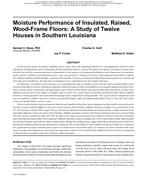Description
In flood-prone areas, elevating a building’s floor system above the anticipated flood level can significantly limit the extent of property damage associated with flooding. In hot and humid climates, such as the Gulf Coast region, raised floor systems may, however, be at risk for seasonal moisture accumulation, as the majority of residential buildings in such climates are now mechanically cooled. Conditions were monitored over a one-year period in a sample of 12 houses with insulated raised floors, eight in New Orleans and four in Baton Rouge, Louisiana. Eleven of the 12 houses were located in flood hazard areas and were constructed with open pier foundations. Several types of insulation were compared across the sample of houses.
In all houses, crawlspace vapor pressure was essentially the same as outdoor vapor pressure and exceeded indoor vapor pressure from May to October. Moisture conditions within plywood or solid wood subfloors were found to depend on several variables: season, indoor temperature during summer, type of interior floor finish, and type of under-floor insulation. In most cases subfloor moisture levels were higher in summer than in winter. For a given type of insulation and interior floor finish, subfloor moisture content generally increased with decreasing indoor temperature during summer. For a given indoor temperature and type of insulation, subfloor moisture content was generally higher under an impermeable finish, such as vinyl tile, than under a more permeable finish, such as carpet.
Floors with foil-faced polyisocyanurate foam board installed below floor joists displayed no discernible seasonal trend in moisture content and little difference between various interior floor finishes. Subfloor moisture readings were consistently in the 10–14% moisture content (MC) range. Floors with closed cell sprayed polyurethane foam showed only a slight seasonal trend and subtle differences between interior floor finishes. Subfloor moisture contents with closed cell foam in all cases were less than 16% MC in plywood and less than 18% MC in solid wood. Clear seasonal trends were observed in floors with open cell foams and with kraft-faced glass fiber batt insulation. Subfloor moisture content readings above 20%, particularly under impermeable interior floor finishes and with low indoor temperatures during the cooling season, suggest that these insulation types do not reliably protect subfloors from seasonal moisture accumulation. For carpeted floors, where subfloor moisture contents were relatively low, application of vapor retarder paint to open cell foam had no discernible effect. In contrast, for floors finished with vinyl, vapor retarder paint applied over open cell foam appeared to result in lower summertime subfloor moisture content, as compared to that for floors insulated with open cell foam without the paint.
Citation: Thermal Performance, International Conference, 2010
Product Details
- Published:
- 2010
- File Size:
- 1 file , 3.7 MB
- Product Code(s):
- D-BUILDINGSXI-46




